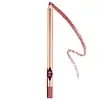What's inside
What's inside
 Key Ingredients
Key Ingredients

 Benefits
Benefits

 Concerns
Concerns

 Ingredients Side-by-side
Ingredients Side-by-side

Ethylhexyl Palmitate
EmollientOzokerite
Emulsion StabilisingRicinus Communis Seed Oil
MaskingBis-Diglyceryl Polyacyladipate-2
EmollientTriisostearyl Citrate
EmollientCetyl Ethylhexanoate
EmollientPolyethylene
AbrasivePPG-51/Smdi Copolymer
Silica
AbrasiveMicrocrystalline Wax
Emulsion StabilisingHibiscus Abelmoschus Extract
MaskingHelianthus Annuus Seed Oil
EmollientCentella Asiatica Extract
CleansingPalmitoyl Tripeptide-1
Skin ConditioningTocopheryl Acetate
AntioxidantButyrospermum Parkii Butter
Skin ConditioningLecithin
EmollientCaprylyl Glycol
EmollientDipalmitoyl Hydroxyproline
Skin ConditioningTribehenin
EmollientPolyglyceryl-10 Heptahydroxystearate
Skin ConditioningHydrogenated Polyisobutene
EmollientHdi/Trimethylol Hexyllactone Crosspolymer
Squalane
EmollientWater
Skin ConditioningSorbitan Isostearate
EmulsifyingEthylene/Propylene/Styrene Copolymer
Pentaerythrityl Tetra-Di-T-Butyl Hydroxyhydrocinnamate
AntioxidantAlumina
AbrasiveButylene/Ethylene/Styrene Copolymer
Calcium Sodium Borosilicate
Calcium Aluminum Borosilicate
Synthetic Fluorphlogopite
Tin Oxide
AbrasivePhenoxyethanol
PreservativeMica
Cosmetic ColorantCI 77891
Cosmetic ColorantCI 77491
Cosmetic ColorantCI 77492
Cosmetic ColorantCI 77499
Cosmetic ColorantCI 19140
Cosmetic ColorantCI 15850
Cosmetic ColorantCI 17200
Cosmetic ColorantCI 42090
Cosmetic ColorantCI 15985
Cosmetic ColorantCI 45380
Cosmetic ColorantCI 73360
Cosmetic ColorantCI 45410
Cosmetic ColorantCI 77742
Cosmetic ColorantCI 77163
Cosmetic ColorantCI 45370
Cosmetic ColorantCI 75470
Cosmetic ColorantEthylhexyl Palmitate, Ozokerite, Ricinus Communis Seed Oil, Bis-Diglyceryl Polyacyladipate-2, Triisostearyl Citrate, Cetyl Ethylhexanoate, Polyethylene, PPG-51/Smdi Copolymer, Silica, Microcrystalline Wax, Hibiscus Abelmoschus Extract, Helianthus Annuus Seed Oil, Centella Asiatica Extract, Palmitoyl Tripeptide-1, Tocopheryl Acetate, Butyrospermum Parkii Butter, Lecithin, Caprylyl Glycol, Dipalmitoyl Hydroxyproline, Tribehenin, Polyglyceryl-10 Heptahydroxystearate, Hydrogenated Polyisobutene, Hdi/Trimethylol Hexyllactone Crosspolymer, Squalane, Water, Sorbitan Isostearate, Ethylene/Propylene/Styrene Copolymer, Pentaerythrityl Tetra-Di-T-Butyl Hydroxyhydrocinnamate, Alumina, Butylene/Ethylene/Styrene Copolymer, Calcium Sodium Borosilicate, Calcium Aluminum Borosilicate, Synthetic Fluorphlogopite, Tin Oxide, Phenoxyethanol, Mica, CI 77891, CI 77491, CI 77492, CI 77499, CI 19140, CI 15850, CI 17200, CI 42090, CI 15985, CI 45380, CI 73360, CI 45410, CI 77742, CI 77163, CI 45370, CI 75470
Cyclopentasiloxane
EmollientSynthetic Wax
AbrasiveIsododecane
EmollientPolybutene
Hydrogenated Cottonseed Oil
EmollientMica
Cosmetic ColorantCeresin
Emulsion StabilisingOzokerite
Emulsion StabilisingMicrocrystalline Wax
Emulsion StabilisingEthylhexyl Palmitate
EmollientSimmondsia Chinensis Seed Oil
EmollientTocopherol
AntioxidantAscorbyl Palmitate
AntioxidantSilica Dimethyl Silylate
EmollientButylene Glycol
HumectantCaprylyl Glycol
EmollientSodium Hyaluronate
HumectantHexylene Glycol
EmulsifyingPhenoxyethanol
PreservativeCI 77891
Cosmetic ColorantIron Oxides
CI 15850
Cosmetic ColorantCyclopentasiloxane, Synthetic Wax, Isododecane, Polybutene, Hydrogenated Cottonseed Oil, Mica, Ceresin, Ozokerite, Microcrystalline Wax, Ethylhexyl Palmitate, Simmondsia Chinensis Seed Oil, Tocopherol, Ascorbyl Palmitate, Silica Dimethyl Silylate, Butylene Glycol, Caprylyl Glycol, Sodium Hyaluronate, Hexylene Glycol, Phenoxyethanol, CI 77891, Iron Oxides, CI 15850
 Reviews
Reviews

Ingredients Explained
These ingredients are found in both products.
Ingredients higher up in an ingredient list are typically present in a larger amount.
Caprylyl Glycol is a humectant and emollient, meaning it attracts and preserves moisture.
It is a common ingredient in many products, especially those designed to hydrate skin. The primary benefits are retaining moisture, skin softening, and promoting a healthy skin barrier.
Though Caprylyl Glycol is an alcohol derived from fatty acids, it is not the kind that can dry out skin.
This ingredient is also used as a preservative to extend the life of products. It has slight antimicrobial properties.
Learn more about Caprylyl GlycolCi 15850 is the pigment color red. It is an azo dye and created synthetically.
Azo dyes need to be thoroughly purified before use. This allows them to be more stable and longer-lasting.
This ingredient is common in foundations, lipsticks, and blushes. This color is described as brown/orangey red.
It has many secondary names such as Red 6 and Red 7. According to a manufacturer, Red 6 usually contains aluminum.
Learn more about CI 15850Ci 77891 is a white pigment from Titanium dioxide. It is naturally found in minerals such as rutile and ilmenite.
It's main function is to add a white color to cosmetics. It can also be mixed with other colors to create different shades.
Ci 77891 is commonly found in sunscreens due to its ability to block UV rays.
Learn more about CI 77891Ethylhexyl Palmitate, also known as octyl palmitate, is created from 2-ethylhexyl alcohol and palmitic acid. It is a fatty acid ester.
The fatty acid content of Ethylhexyl Palmitate makes it an emollient. Emollients help soften and hydrate your skin by trapping moisture within.
Ethylhexyl Palmitate is also used to help improve the texture of cosmetics. It helps other ingredient dissolve in products and help disperse ingredients more evenly.
You'll likely find this ingredient in sunscreen, as it is often used to mix UV-blocking ingredients such as avobenzone and ethylhexyl triazone.
It can also help stabilize the fragrances in a product as a fragrance fixative.
Ethylhexyl Palmitate can be used to substitute mineral oil.
Due to its high fatty acid content, it may not be fungal-acne safe.
Learn more about Ethylhexyl PalmitateMica is a naturally occurring mineral used to add shimmer and color in cosmetics. It can also help improve the texture of a product or give it an opaque, white/silver color.
Serecite is the name for very fine but ragged grains of mica.
This ingredient is often coated with metal oxides like titanium dioxide. Trace amounts of heavy metals may be found in mica, but these metals are not harmful in our personal products.
Mica has been used since prehistoric times throughout the world. Ancient Egyptian, Indian, Greek, Roman, Aztec, and Chinese civilizations have used mica.
Learn more about MicaMicrocrystalline Wax is created by de-oiling petroleum. It is highly refined and purified before being added to cosmetics.
Microcrystalline Wax is used to enhance the texture and create even consistency. It helps stabilize a product by preventing ingredients from separating.
Ozokerite is a naturally occuring mineral wax. In cosmetics, ozokerite is used as a texture enhancer.
Ceresin wax is derived from this ingredient.
The melting point of ozokerite is 58-100 C.
Ozokerite is found all over the world including Scotland, the US, and India.
Learn more about OzokeritePhenoxyethanol is a preservative that has germicide, antimicrobial, and aromatic properties. Studies show that phenoxyethanol can prevent microbial growth. By itself, it has a scent that is similar to that of a rose.
It's often used in formulations along with Caprylyl Glycol to preserve the shelf life of products.